Scottish Employer Skills Survey 2020
Results from the Scottish Employer Skills Survey 2020.
Recruitment and skill-shortage vacancies
This chapter looks at the proportion of employers with vacancies at the time of the survey and whether they were having any difficulties filling these vacancies. It specifically looks at instances where these difficulties were caused by a lack of skilled applicants, and the impact of these skill shortages on employers.
Vacancies
Overall, one-in-nine (11%) employers had a vacancy at the time of the survey.
This is a decrease from 2017, when 20% of employers reported having a vacancy. When comparing the difference here, it is worth noting that the fieldwork for the 2020 survey was carried out later in the year (October to December) than for the 2017 survey (May to October), which will mean any seasonal differences in recruitment patterns will be reflected in these figures. The survey was also undertaken during the COVID-19 pandemic at a time when employers were subject to varying restrictions on their operations. The impact of COVID-19 on employer behaviour, as measured by the survey, is discussed in a dedicated section below.
The largest decreases in the proportion of employers with vacancies were among employers in the Glasgow Region (26% in 2017 down to 10% in 2020) and Lanarkshire Region (24% down to 8%). Conversely, there has been virtually no change in the proportion of employers with vacancies in Borders Region (7% in both years) and Highlands and Islands Region (16% in 2017 and 15% in 2020).
"Vacancy Density" refers to the number of vacancies as a percentage of total employment. This figure was 1.9% in 2020, meaning that for every 100 people employed in Scotland there were approximately 2 vacancies. This figure was down from 3.1% in 2017.
Figure 3 shows vacancy measures for Scotland and by ROA region.
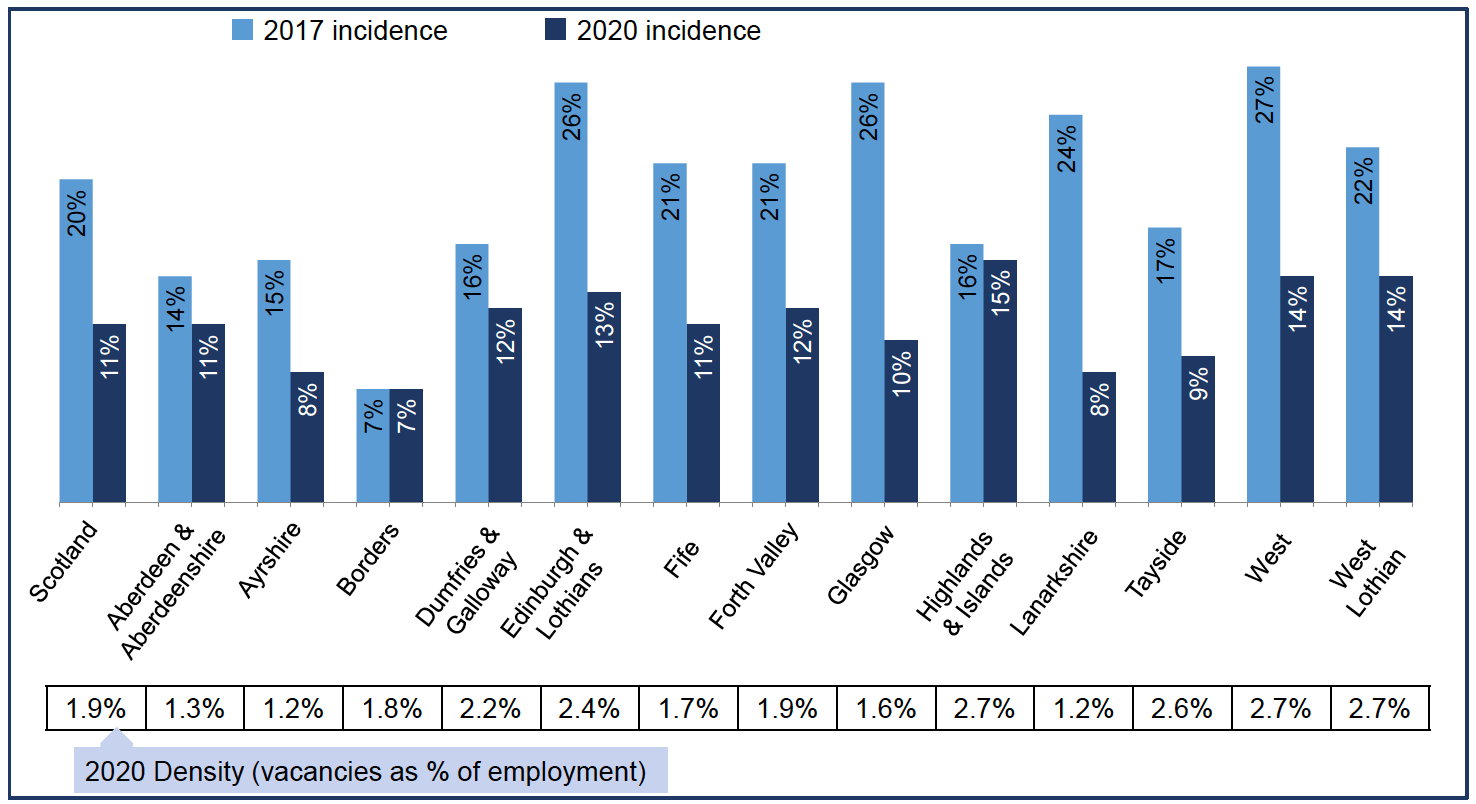
Base: All establishments (3,497). Regional bases range from 87 in West Lothian Region to 500 in Highlands and Islands Region.
"Regions" refer to ROA regions – see "Definitions" section of this report for more detail.
The incidence of vacancies varied considerably by size, with just 4% of establishments with 2-4 staff reporting vacancies at the time of the survey compared to 57% of those with 100 or more. Density of vacancies, however, remained reasonably consistent by size of establishment.
There was also large variation by sector with around a third of employers in the Education (36%) and Public Administration (33%) reporting vacancies, compared to 3% in the Primary Sector and Utilities.
Further data on the incidence and density of vacancies, as well as corresponding 2017 results, can be found in Tables 1 to 3 of the Background Tables accompanying this publication.
Skill-shortage vacancies
Vacancies which are hard to fill because of difficulties finding applicants with the requisite skills, knowledge and/or experience are known as "skill-shortage vacancies", or "SSVs". Looking at the level of skill-shortage vacancies in the market is a good indicator of skill supply issues in an area.
Overall, a quarter (24%) of establishments with vacancies reported at least one that was hard to fill due to a skill-shortage issue. This equates to 3% of all establishments in Scotland.
The proportion of all establishments with any skill-shortage vacancies has fallen from 6% in 2017 to 3% in 2020 (see Figure 4).
The overall skill-shortage vacancy density (skill shortage vacancies as a proportion of vacancies) was 21%, similar to the figure seen in 2017 (24%); this measure is known as the "SSV density".
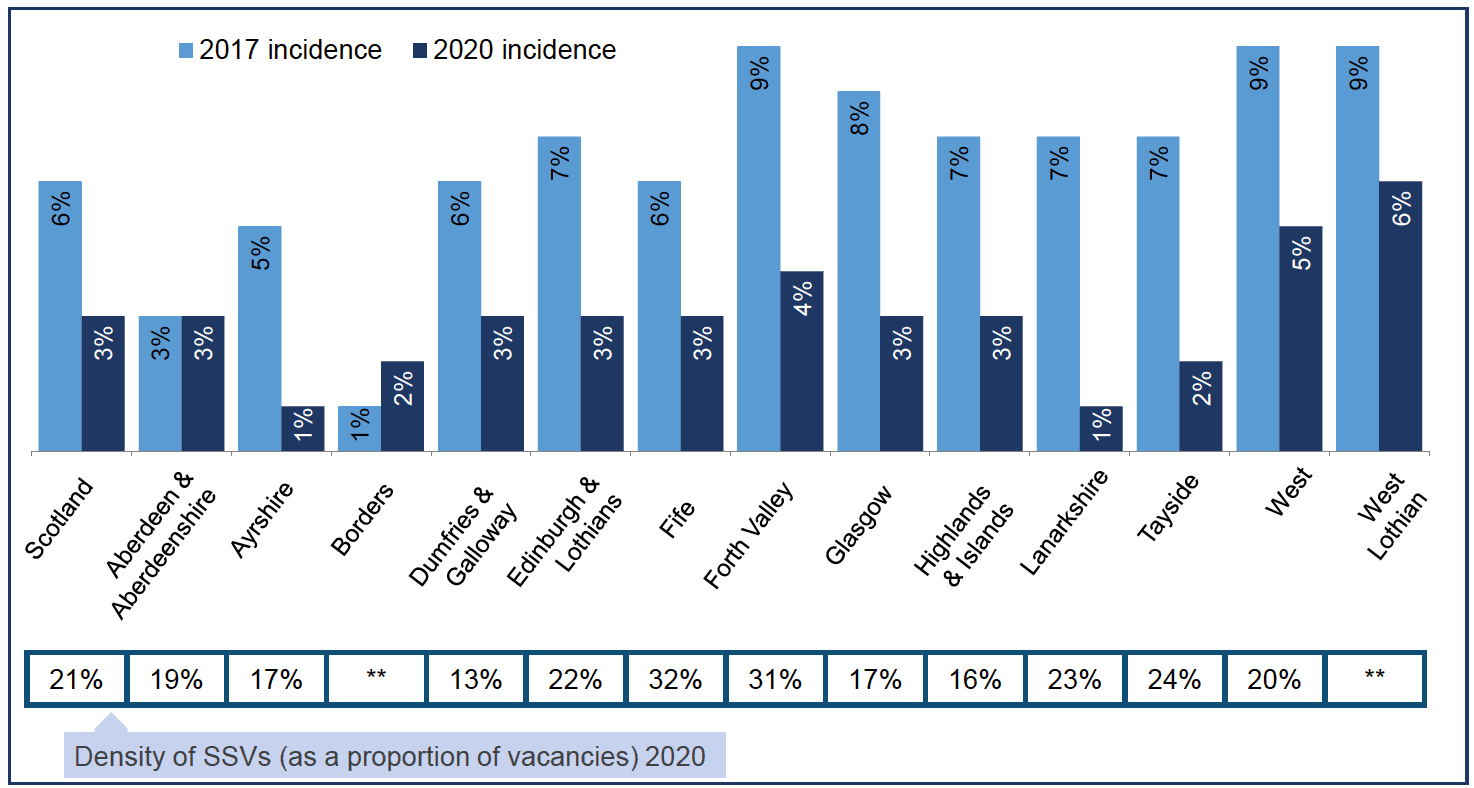
Base: All establishments (3,497). Regional bases range from 87 in West Lothian to 500 in Highlands and Islands.
Base for density figures: Establishments with vacancies (637; base sizes by region vary from 12 to 105)
**Data suppressed, base <30.
"Regions" refer to ROA regions – see "Definitions" section of this report for more detail.
As with the incidence of vacancies, larger establishments were more likely to report having skill-shortage vacancies than smaller employers: 17% of employers with 100 or more staff had at least one SSV, compared to just 1% of those with 2-4 staff. SSV density did not differ significantly across the different sizes of establishments.
In line with their higher incidence of vacancies generally, establishments in Public Administration (10%) and Education (9%) were the most likely to report having any skill-shortage vacancies.
Further size and sector breakdowns, as well as corresponding 2017 results, can be found in Tables 4 to 6 of the Background Tables.
Skills lacking in the labour market
Skills that employers perceive to be lacking among applicants to their roles can be grouped into two broad categories: technical and practical skills, which are specific skills required to perform the particular functions of a job role, and people and personal skills which are the "softer", less tangible skills required to manage oneself and interact with others in the workplace.
Looking first at technical and practical skills, the most common reported skill-shortage was in the specialist skills or knowledge required for the job in question. This was given as the cause, at least in part, of 58% of all skill-shortage vacancies.
Almost half of skill-shortage vacancies were caused, at least in part, by a lack of knowledge about the organisation being applied to, whether that was the products and services offered or how the organisation works.
Complex analytical skills were lacking among applicants for 44% of skill-shortage vacancies.[3]
Over a third of skill-shortage vacancies were due at least in part to a lack of applicants with basic IT or numeracy skills (37%), and digital skills specifically (advanced or basic) were an issue in 35%.
Figure 5 gives a full breakdown of the technical and practical skill lacking among applicants where employers report having skill-shortage vacancies.
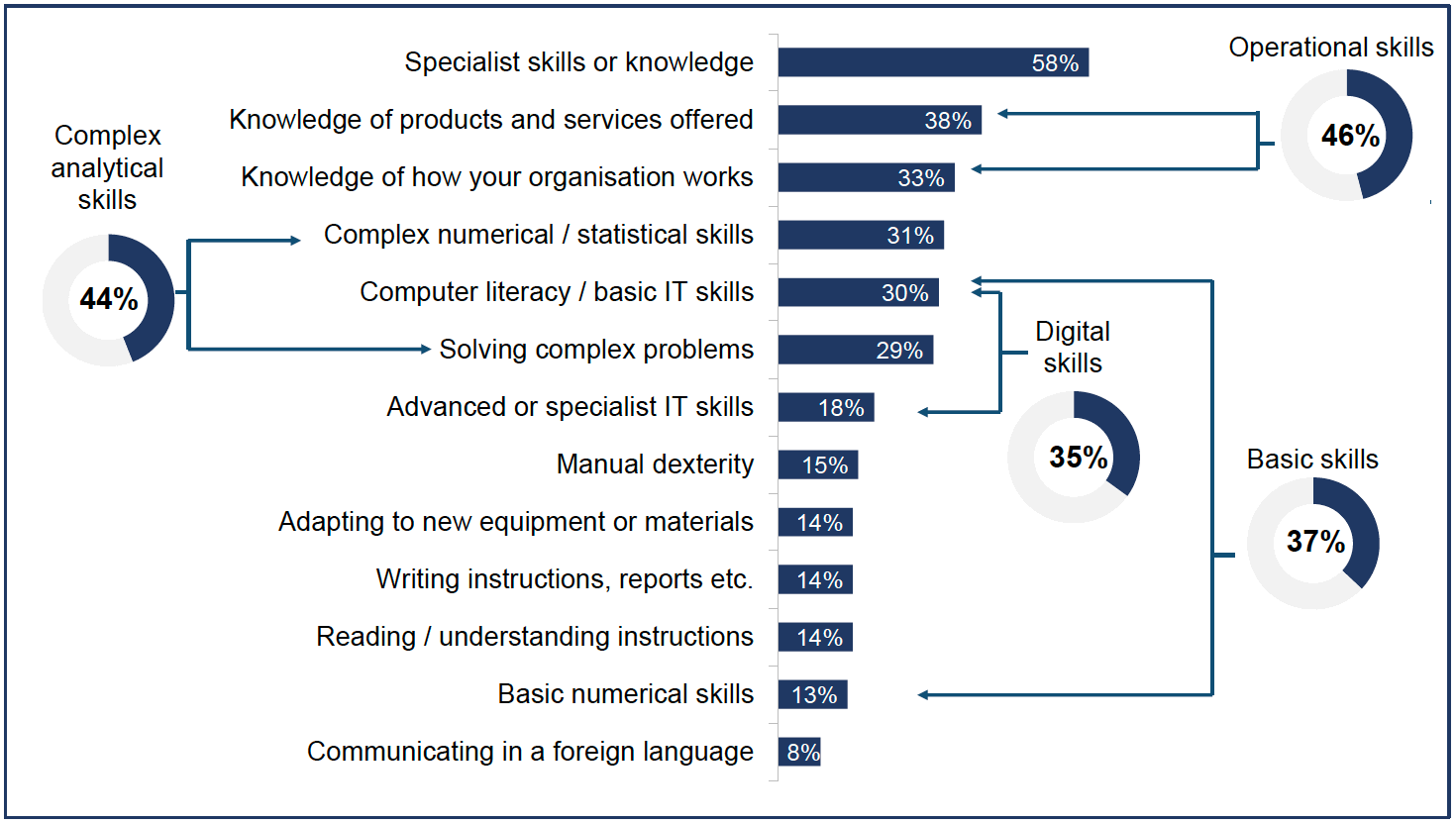
Base: All establishments with skill-shortage vacancies (2020: 153)
Figures shown based on SSVs for up to 2 occupations randomly selected for each establishment) – so, for example, "specialist skills or knowledge" was lacking among applicants for 58% of SSVs followed up. Respondents were able to select multiple skills for these questions; as such grouped skills will not equal the total of the individual skills included in that grouping.
Turning to people and personal skills (shown in Figure 6), the most common skill lacking among applicants was self-management, with 58% of skill-shortage vacancies caused at least in part by this. Around half (51%) of skill-shortage vacancies were caused, at least in part, by an inability to find applicants who can manage their own time and prioritise tasks, and 28% by a lack of applicants with the ability to manage their own or others' feelings. Team working and creative and innovative thinking were also often felt to be lacking by employers, cited as a factor in 37% and 36% of skill-shortage vacancies respectively.
Management and leadership skills (covering the ability to manage or motivate other staff, instructing, teaching and training people, and setting objectives for others and planning resources) were lacking in 36% of skill-shortage vacancies. The specific management and leadership skill most often lacking was the ability to manage or motivate other staff (a factor in 31% of all SSVs), followed by instructing, teaching and training people (21%) and setting objectives for others and planning resources (12%).
Sales and customer handling skills were lacking among applicants for 32% of skill-shortage vacancies.
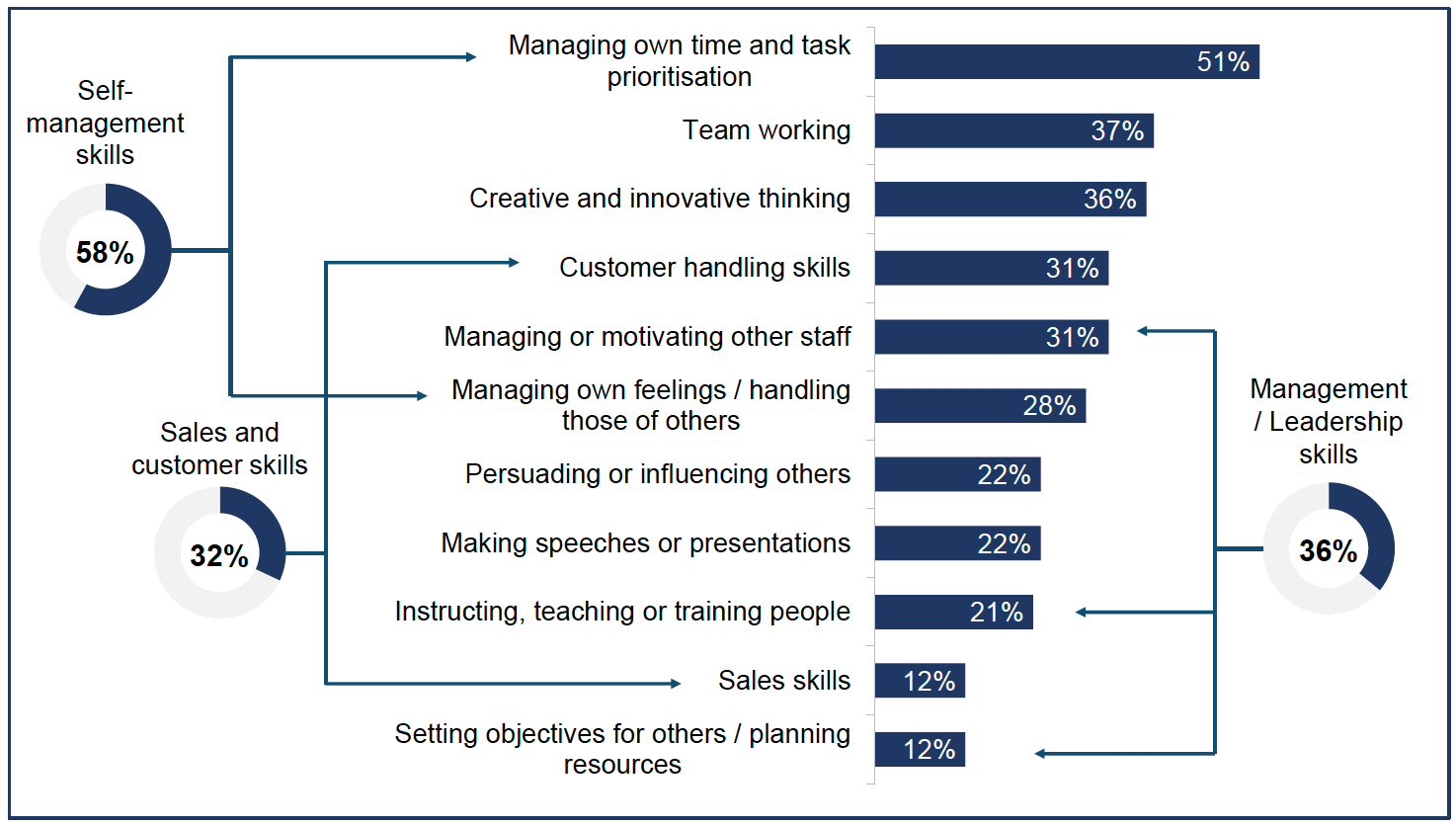
Base: All establishments with skill-shortage vacancies (2020: 153)
Figures shown based on SSVs for up to 2 occupations randomly selected for each establishment – so, for example, "managing own time and task prioritisation" was lacking among applicants for 51% of SSVs followed up.
Impact of skill-shortage vacancies on employers
The vast majority (95%) of employers that had experienced hard to fill vacancies that were all a result of skill shortages said these had an impact on their organisation. This was similar to the proportion reported in 2017 (97%).
The most common impact of skill-shortage vacancies was an increased workload for other staff, reported by 83% of establishments where all their hard-to-fill vacancies were caused at least in part by skill-shortages,[4] a decrease since 2017 (89%). This was the only impact of skill shortage vacancies for around one in eight (12% of) establishments with hard-to-fill vacancies that were all as a result of skill shortages (consistent with the 11% found in 2017). The next most common impact was difficulties meeting customer service objectives (49%). Some impacts of SSVs directly affect business performance: 40% reported SSVs leading to increased operating costs and 36% to losing business to competitors.
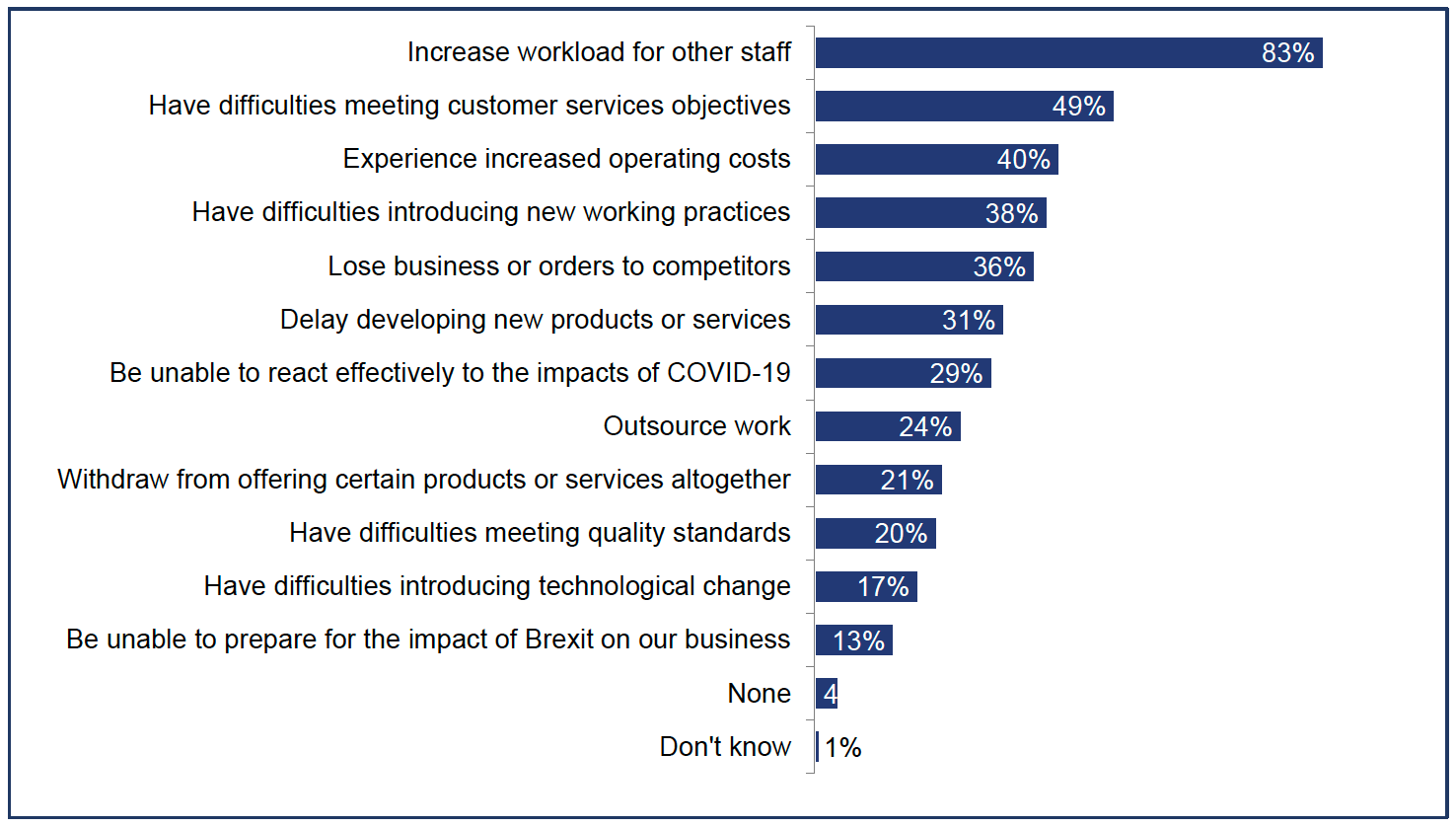
Base: All establishments with hard-to-fill vacancies that are all as a result of skill shortages (142).
The proportion of establishments with SSVs reporting each impact has decreased compared with 2017 for most impacts, with the fall particularly marked for SSVs causing a delay in developing new products (31%, down from 44% in 2017).
Nearly a third of establishments with hard-to-fill vacancies that were all a result of skill shortages said these SSVs affected their ability to react effectively to the impacts of COVID-19 (29%).
Contact
Email: FHEstatistics@gov.scot
There is a problem
Thanks for your feedback